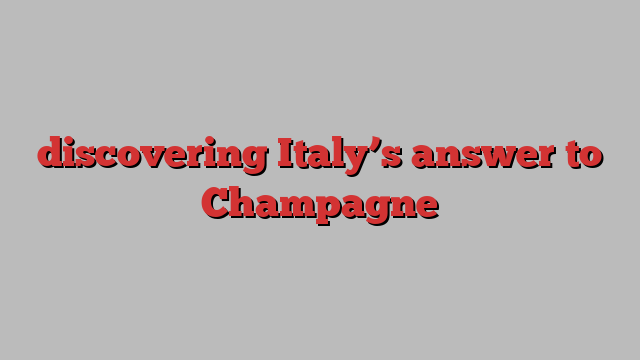
Franco Ziliani had a hunch. To the young oenologist, the unique topography of Franciacorta, a glacial basin in the region of Lombardy near his native Brescia, looked ripe for producing a certain type of wine that no one had tried there before. The region’s terroir seemed ideal for Chardonnay and Pinot Noir to thrive: the mountains in the south offer mineral-rich, tectonic soil and hold in fresh air from the alpine lake to the north, which in turn keeps winters mild and summers breezy.
In 1955, Ziliani approached some local producers with a bold idea: “What if we made a sparkling wine the way the French do?”
But Franciacorta didn’t produce much wine back then, and the few commercial wineries that existed typically made rustic reds — table wine. In any case, Italian sparkling wine was usually made in the metodo italiano, as it had been done for hundreds of years. Only the aristocrat Guido Berlucchi would give Ziliani a chance — and his estate’s grapes to work with. It started a revolution.

Today Franciacorta is known as the “Champagne region of Italy”, producing some 20mn bottles of the eponymous world-class sparkling wine each year, made in the metodo classico with primarily Chardonnay and Pinot Noir grapes. The region’s rolling vineyards and elegant DOCG wines, characterised by freshness, structure and balance, its destination hotels and charming historical sites, are increasingly popular with holidaymakers and wine tours yet remain relatively under-the-radar for international visitors and consumers. (Only about 12 per cent of Franciacorta’s annual production is exported and it remains dwarfed by Champagne, which produces around 300mn bottles a year.)
With Franciacorta’s proximity to the Lakes, its peak tourism season runs throughout the summer months, though autumn is a magical time to visit, with fewer travellers, pleasant temperatures and clear skies for exploring and stargazing, and a smattering of gold foliage alighting on the landscape.
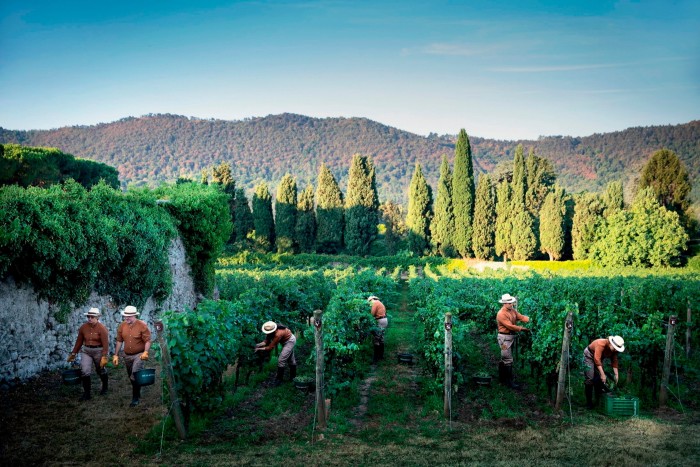
We’re visiting in early September — the tail-end of Franciacorta’s vendemmia (harvest) — and the vineyards are dotted with hunched-over figures, handpicking grapes by carefully selecting only the fruit worthy of pressing. There could be no doubt that this is wine country: almost every bit of Franciacorta’s 200 square kilometres that is not a road or a building is covered with vines. Street names are wine-related too: Via Franciacorta, Strada del Vino, and so on. It’s hard to believe that all of this hasn’t been here long.
“Franciacorta is very young. We’re still at the beginning [of our story]”, says Alessandra Messora, our tour guide at Bellavista, the first winery we visit, as we take in the company’s namesake view from its perch in the hills of Erbusco, the commune that’s considered the heart of the region. She explains how the borders of Franciacorta territory are marked by natural features, notably the verdant mountain range that makes up its southern flank — an amphitheatre that faces north to the turquoise waters of Lake Iseo.
Once inside the winery, the influence of Italy’s fashion and design capital — Franciacorta is about an hour’s drive from Milan (and just two hours from Venice) — comes into focus. The front-of-house staff, who appear to be an all-women team, wear matching navy pussy-bow blouses, while the reception area — and tasting room, I later discover — is stylishly decorated, fit for an Italian 007 who drinks Bellavista not Bollinger.
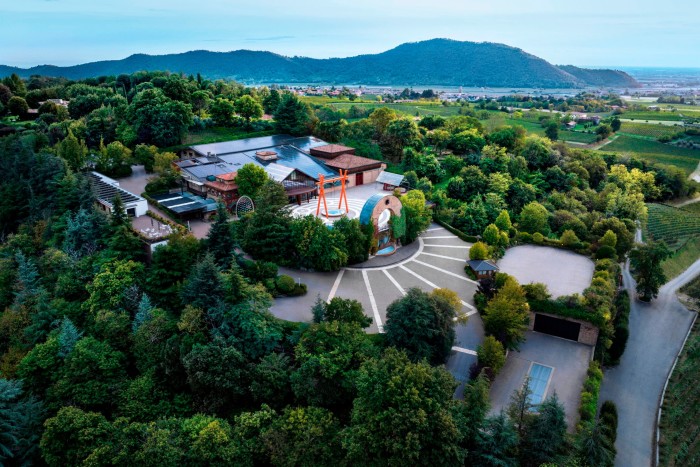
Of Franciacorta’s 123 producers, Bellavista has emerged as one of the most important and its owner, the 83-year-old construction titan Vittorio Moretti, one of the wealthy Lombards who started viticultural estates in the wake of the Ziliani-Berlucchi experiment, is one of the region’s most respected figures. Before Moretti started Bellavista in the late 1970s, he travelled to Champagne to learn everything he possibly could about traditional-method sparkling wine, and returned to Franciacorta to set up his estate. Bits of historic equipment, including a Marmonier wine press that is still in use, are dotted around the property.
Messora brings us to an enormous warehouselike space to see the fermentation tanks, including “the mother” — a behemoth 2,750-hectolitre steel cylinder used for making Bellavista’s cuvée, the Alma Brut (RRP €31) — “our business card,” she says, of which around 1mn bottles are produced per year. “It’s the most popular but the most complex to realise.”
Like winemakers the world over, Franciacorta producers are grappling with how to mitigate the effects of climate change; unpredictable weather means that maintaining consistency, especially in cuvées that are expected to taste exactly the same from year to year, is increasingly difficult to achieve. “[The weather] was great this year until August, then huge storms hit and ruined some of our vineyards,” Messora says. “We still don’t know what percentage of production we’ll lose.”
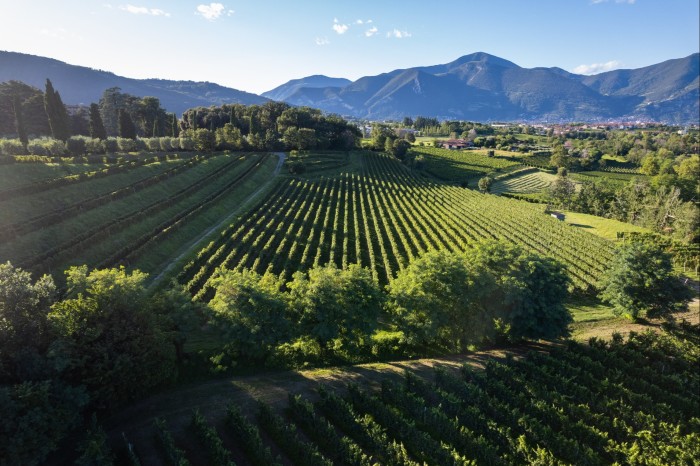
A warming climate is also troublesome for wines such as Franciacorta that are distinguished by their freshness and meant to be relatively low ABV at 12–12.5 per cent (riper fruit has more sugar for yeast to convert to alcohol). One solution is to plant higher and higher up the mountains, but that presents other difficulties in terms of accessibility. Otherwise, there’s nowhere else to go. The region is hemmed in by its natural borders, and winemakers fear that expanding beyond those will affect quality. The easiest place to stretch the boundary would be to the opposite side of Monte Orfano in the south, but it has a different climate and soil type from its Franciacorta side, and crucially, it acts as a blockade for pollution from the Po Valley, which has some of the worst air quality in Europe.
The Italian Ministry of Agriculture and the Franciacorta DOCG consortium, the region’s official body, came up with another idea, approving the use of a long-forgotten indigenous white grape called Erbamat, known for its late-ripening and high acidity. The uptake, however, has been minimal: of the three producers we visit, none use it and currently have no plans to. “It’s too sharp,” Messora says.
As we sit down for a tasting of three Bellavista wines, I understand the hesitation. They are wonderfully balanced: delicate and soft, but crisp and structured. My favourite is the Scala Brut (€50), named after Milan’s historic opera house, for its smoothness and energy, and we buy a magnum to take home for New Year’s Eve.
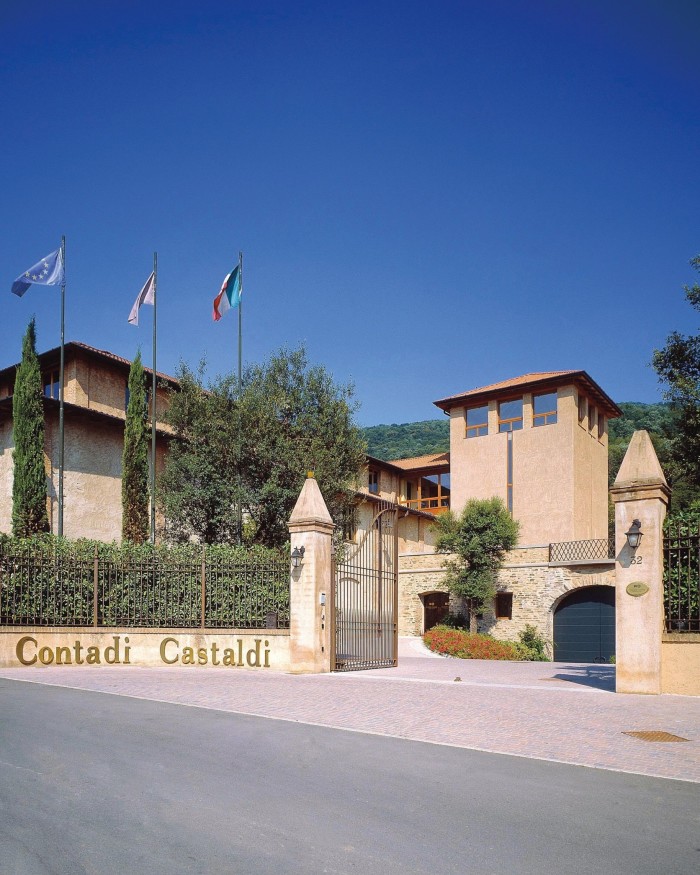
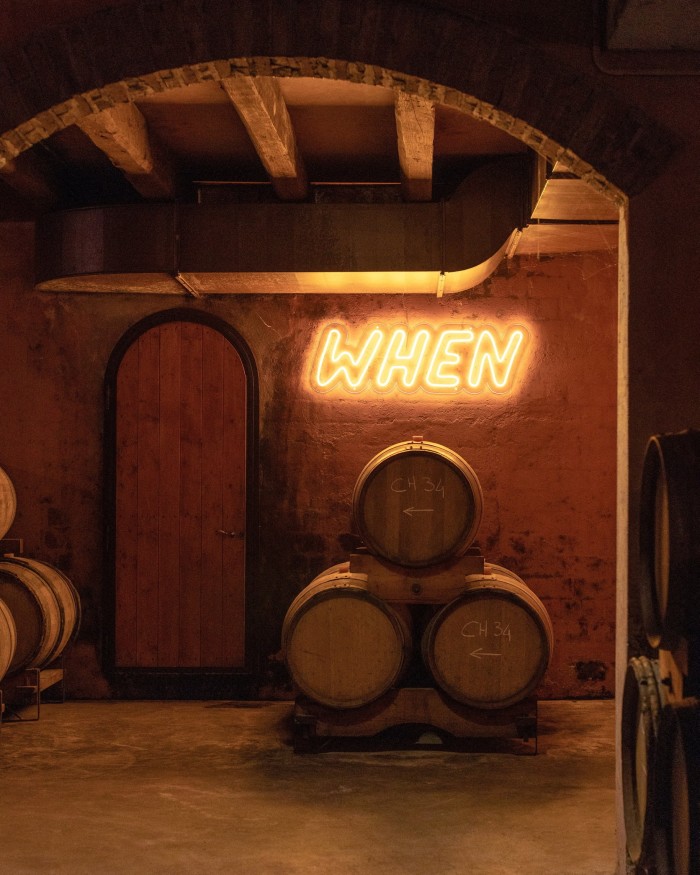
After a short drive through verdurous hillsides, past stone houses with terracotta roofs, cypress and olive trees and rows and rows of happiness-yielding vines, we arrive at Contadi Castaldi, a contemporary winemaker near the town of Adro. Its base feels more like the headquarters of a youth culture magazine or a fashion photography studio, with dark walls, silver curtains and neon signage posing pressing questions like “Wine not?”.
Unlike academic producers such as Bellavista, here bottles are not hand-turned during the second fermentation — an arduous, time-consuming and expensive process — but rotated using a machine. “We don’t think it actually makes a difference in the wines,” our tour guide says. “And it’s less dangerous to do it this way,” she adds, noting how bottles can explode during fermentation.
Contadi Castaldi also does not own any vineyards but sources its grapes from local growers; a cuvée might include yield from 30-40 different parcels of land. One of the most interesting wines that we taste here, however, does not — the Contadi Castaldi Blànc (€27), which is made with 50 per cent Pinot Blanc grapes (the rest is Chardonnay), which are difficult to grow. But Contadi Castaldi has found a local farmer with a skill for cultivating the plants, and the result is an apple-scented, dry and acidic wine, which would pair brilliantly with oysters.
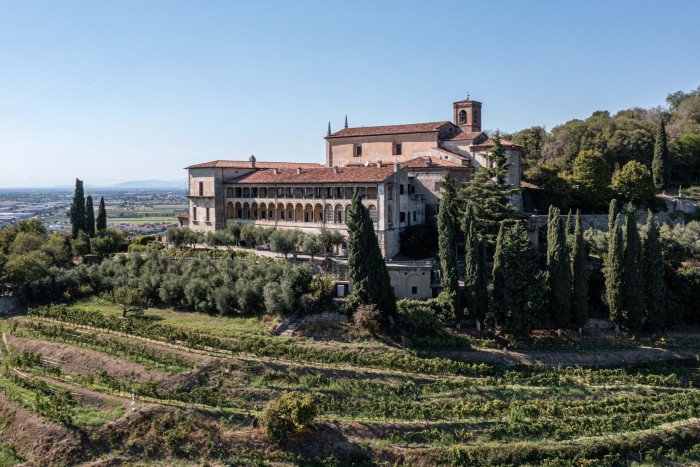
The next day, we ascend Monte Orfano for a touch of culture (and a wink more booze), inching our non-Italian-sized car up a narrow road in search of the Convento dell’Annunciata. Founded in 1449 by an order of Franciscan friars, it is a fascinating site, with panoramic views of the Padana plain. Its church was used in the 17th century as an infirmary, as ordered by Venetian authorities, its walls sterilised with quicklime, which damaged several Romanino frescoes that were not discovered until the religious order returned after hundreds of years and carried out a restoration. The only fully intact work lies above the altar, depicting the angel Gabriel appearing to Mary, with what they suspect is Monte Orfano in the background. It’s one of the most significant artworks in the region.
Tumbling down the Convento’s hillsides are ancient vineyards that documents show date back to the late Middles Ages; today it is one of the region’s rare producers of still wine, each year making around 25,000 bottles of Chardonnay and just a few hundred Merlot. The white has a lovely fruity aroma, freshness on the palate and nice acidity, though curiosity wins: the red isn’t available for tasting so we buy a bottle to try later.
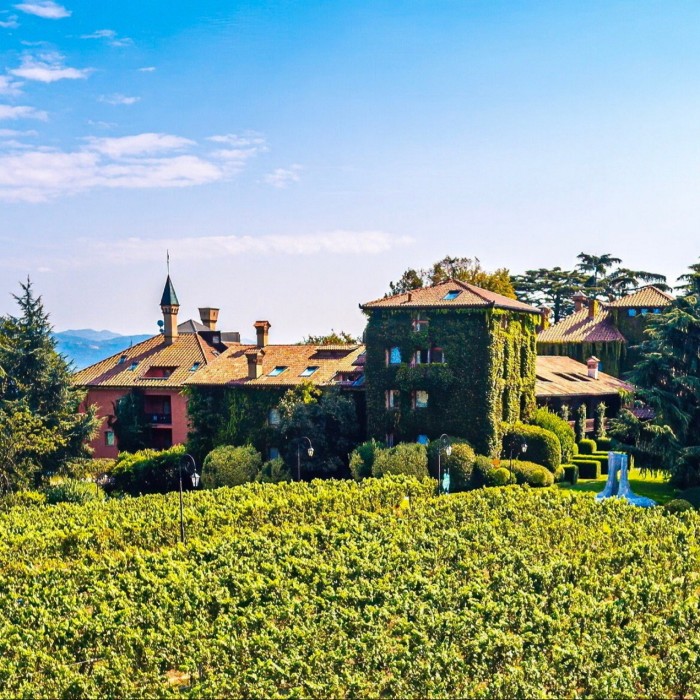
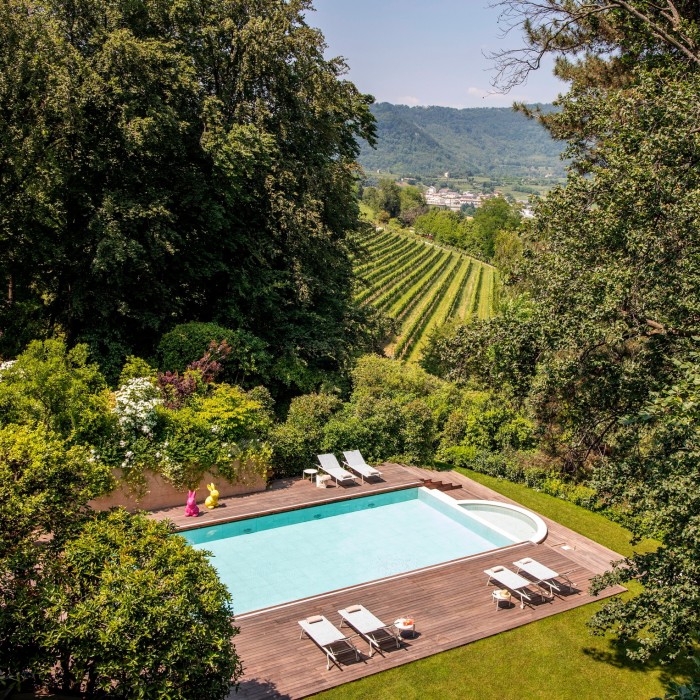
Back at L’Albereta, our hotel, we take a break from sightseeing to read by the peaceful, outdoor swimming pool, tucked behind the ivy-clad building among a swath of trees. The whole site feels more like a grand house than a hotel, though it has all the slick amenities one can think of, including several top-quality restaurants, the jewel of which is the Michelin-approved LeoneFelice Vista Largo, with its spectacular view of Lake Iseo and a wine list that could make even an avid collector swoon.
The hotel has become a popular bolt-hole for well-heeled Milanese weekenders. “But even Italians don’t know enough about Franciacorta,” says Diana Toniolo, L’Albereta’s sales and marketing director. “I’m from Venice, and I used to just drive through on the motorway to go to Milan.”
As we peel away for the next stop on our trip, the vines vanishing behind the traffic-choked motorway, I think how easy it would be to do so. Franciacorta somehow remains Italy’s sparkling secret. But if you know, you know.
Tasting notes
What to drink
Franciacorta is characterised by its freshness, minerality and structure. Whites tend to be dry and apple-scented, while rosés offer a bit more depth, with a spicy, red-fruit aroma. They are relatively low AVB (around 12 to 12.5 per cent), made with Chardonnay and Pinot Noir grapes, and sometimes small amounts of Pinot Blanc. In 2017 the native white grape Erbamat was approved for inclusion (up to 10 per cent in blends).
These wines are modelled closely after Champagne: as well as using the same grape varieties, Franciacorta is made in the traditional method (meaning the secondary fermentation is carried out in the bottle). Producers also use French rather than Italian terminology on their labels: rosé instead of rosato, for example, as well as the designations noting sugar (such as brut and extra brut). Though all Italian sparkling wines are technically spumante, the word is not permitted on Franciacorta labels — they are careful to avoid association with off-dry or inexpensive products.
Drinking windows depend on the individual wine, but like champagne (and other traditional-method sparkling wine), the general rule of thumb is that non-vintage Franciacorta should be enjoyed within five years, and vintage wines can be cellared for up to a decade, some longer.
Some suggestions for . . .
An introductory wine: Bellavista Alma Grande Cuvée Brut (£34.25, vinvm.co.uk)
Serves as a good welcome wine to Franciacorta, introducing the region and the style. It drinks well as an aperitivo. It’s 80 per cent Chardonnay, one per cent Pinot Blanc and the rest is Pinot Noir.
A classy choice with wide appeal: Bellavista Teatro alla Scala Brut (£41, vinvm.co.uk)
An elegant and versatile wine with both softness and structure. It would drink well as an aperitivo or with food. It’s 75 per cent Chardonnay, 25 per cent Pinot Noir.
An interesting and unexpected option: Contadi Castaldi Blànc (€27)
An unusual wine for the region, made with 50/50 Pinot Blanc and Chardonnay. Pinot Blanc is a less-resilient plant than Chardonnay, hence why it’s not typically used so much, but this winery works with a local farmer who has a knack for growing it. It is apple-scented, dry and acidic, and would pair well with foods with salinity, like oysters or crudo.
Something bone-dry: Contadi Castaldi Zèro (€29)
A zero-dosage blend, meaning there is no added sugar, so it is bone-dry and acidic. It would pair well with fatty or oily food, such as fried fish or salami, though is also crisp and refreshing on its own. Fifty/fifty Chardonnay and Pinot Noir.
Dinner parties and big groups: Enrico Gatti Franciacorta Brut (€23, bottleofitaly.com)
A fresh, aromatic and sophisticated wine — a fine example of a Franciacorta — and well priced for occasions that require purchasing plenty.
Where to eat
Excellent pizza: La Filiale, Erbusco
A fairy-lit pizzeria in the hills of Erbusco from Franco Pepe, a celebrated pizzaiolo. Pies are Neapolitan in style with a thin, gooey centre and charred, puffed crust. Order a bunch to share so you can try as many as possible.
Traditional specialities: Osteria Quattro Rose, Rovato
A charming restaurant in the village at the bottom of Monte Orfano, near the Convento dell’Annunciata. It is best known for its manzo al olio (beef in extra- virgin olive oil, served here with polenta) — the signature dish of the Franciacorta region that is believed to have been invented on the grounds of the Convento, which held a medieval cattle market among its olive groves.
Near the shores of Lake Iseo: Radicì, Iseo
Beneath the Castello Oldofredi, a historic residence that is now a hotel in a fishing village by the lake, this restaurant serves modern, upscale cuisine with local ingredients. Expect skilfully made pasta dishes and plenty of fresh fish.
Something fancy: Ristorante LeoneFelice Vista Lago, Erbusco
Italian fine dining without the fuss. This restaurant has a striking view of Lake Iseo with warm, personable service and dishes that are impressively put together and refined, but still comforting and homely. The wine list is spectacular. Make a reservation during peak periods.
— Niki Blasina
Niki Blasina was a guest of Eurotunnel LeShuttle and L’Albereta Relais & Châteaux (doubles from €360). Tours of the Bellavista winery (including a tasting), from €40; tours of the Convento dell’Annunciata, €25